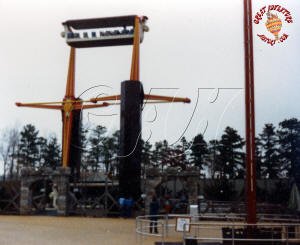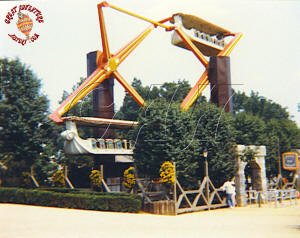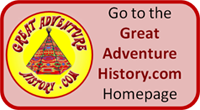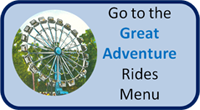 |
Joust-A-Bout was
added to the park in the 1982 season, at the far end of Goodtime Alley,
the park's main games area.
After the original Goodtime Alley was destroyed by fire during the off
season, a new and much improved games area was built, with a unifying
theme created with the metal and blue facades and thousands of chasing
lights.
The top left picture is from the Season Pass flyer for 1982, and shows a
portable version of the ride as it appeared during Oktoberfest in
Munich, complete with its Asian theme elements and backdrop.
The top right picture shows the parts of the Joust-A-Bout arriving on
site, still painted in primer red. In the background, the
two "boats" sit with their roofs folded in half from their journey
across the Atlantic. Everything including the fringe is
already in place and simply awaiting assembly.
To help draw guests down through the games, an attraction was needed
which could be seen from a distance, and Joust-A-Bout fit the bill with
its height and motion which was further accentuated at night with its
hundreds of lights.
The ride was a park model Schwarzkopf Dschunke (Chinese Junk) ride, also
known as a Flying Carpet, and was the only one of its kind in the United
States. The ride offered a family thrill ride with height
and speed.
The ride had various cycle options. In the 80's, the cycle consisted of
both clockwise and counter clockwise rotations. In the 90's it was
changed to just counter clockwise.
The entrance queue traveled directly underneath the path of the arcing
boats. Taller guests were actually able to touch the boat when it
passed. When the boats traveled in a clockwise direction, guests would
dash down the queue because it appeared that the falling boat was going
to crush them especially when they traveled at full speed. |


 |
| |
 |
| |
|
 |
 |
| |
|
 |
 |
| |
|
|
|
Technical Information |
|
|
|
|
|
|
Manufacturer: |
Schwarzkopf |
|
|
Ride
Model: |
Dschunke (Junk)
aka Flying Carpet Ride |
|
|
Type: |
Stationary model |
|
|
|
|
|
|
Opening
Date: |
April 7, 1982 |
|
|
Closing
Date: |
November 1, 1998 |
|
|
|
|
|
|
Width: |
Approx. 64 ft |
|
|
Depth: |
Approx. 30 ft |
|
|
Height: |
Approx. 59 ft |
|
|
Flight
Path: |
Approx. 75 ft |
|
|
|
|
|
|
Capacity: |
Approx. 960 persons per hour |
|
|
|
|
|
|
Seats: |
2 boats |
|
|
|
32 passengers per boat |
|
|
|
8 rows per boat with 4 integral-foamed seats
each |
|
|
|
All rows face center - 4 face right and 4
face left |
|
|
|
|
|
|
Restraints: |
Guests are secured in pairs by padded lap
bars. |
|
|
|
|
|
|
Features: |
Boats are covered by fiberglass and
illuminated |
|
|
|
by translucent ornamentation |
|
|
|
|
|
|
Total
Power Required: |
Approx. 130 kW power |
|
|
|
Appox. 40 kW illumination |
|
|
|
|
|
|
Total
Weight: |
Approx. 70 tons |
|
|
|
Four 40' containers |
|
|
|
|
|
|
 |
 |
| |
|
|
 |
 |
 |
| |
|
|
 |
 |
 |
| |
|
|
 |
 |
 |
| |
|
|
 |
 |
 |
|
|
 |
 |
| |
|
 |
 |
| |
|
|
 |
The ride's cross bars were
functional for stability and balance. In addition they provided an
excellent visual effect similar to a taffy pulling machine.
Passengers had to wait either before or after their ride while the other
boat was loaded. The movement to switch boat positions was referred to
as "jogging".
The NJ Permit to Operate sticker listed the ride as "Flying Carpet Ride"
- appropriate given the fringe encircling each boat's top. |
 |
| |
|
|
 |
Watch Video Of
Joust-A-Bout
In Action:

|
| |
 |
| |
|
|
 |
The main motors that drove the ride were
located in the rear main column next to the operator's booth.
Consideration had to be given to make sure that the boats were equally
balanced. The differential between Boat A and Boat B had to be eight
guests or less.
The opening in the deck of the ride was appropriately referred to as
"the pit". In 1982, the opening did not exist - the boards spanned the
cutout.
The ride went through an extensive rehab in 1991, and was closed for a
large part of the season.
Over the seasons what had seemed like a very tall ride was dwarfed by
its new neighbors, first with Parachuter's Perch in 1983, then with
Sarajevo Bobsled in 1984, and later with Great American Scream Machine
added in 1989. Together they all served the purpose of
drawing guests into the games area.
After the addition of the Parachuter's Perch next to it, the
Joust-A-Bout was a frequent victim of lightning strikes, which wreaked
havoc on the rides computer control system. |
 |
| |
|
 |
 |
| |
 |
| |
|
 |
 |
| |
|
|
 |
 |
 |
| |
|
 |

When Time Warner took ownership of Six Flags an
effort was made to bring themes to areas of the park which were created
in a mix of styles and themes over the years with no coherent overlying
theme.
The area at the top of the Boardwalk games area was themed as part of
the addition of the Right Stuff Mach 1 Adventure, and the area was given
the look of an Air Force base. Joust-A-Bout became the Sky
Pilot as part of this makeover, and the ride was painted in red and
blue, with a black and white support column in front. The
sign and logo given to the ride suggested almost a Jules Verne style
rocket, suggesting this was some sort of crazy idea of a flying machine.
Sky Pilot operated until the end of the 1998 season, when it was removed
to make way for the new Twister ride which still occupies that space.
The Sky Pilot had been suffering downtime and the ride's manufacturer
had gone out of business.
Today the part of Joust-A-Bout in its Sky Pilot paint scheme lays in the
park's "boneyard". The ride's parts are visible from Route 537
in the winter when the trees are bare. |
 |
| |
|
 |
 |
| |
 |
| |
|
 |
 |
| |
|
|
 |
| |
|
|

_small.jpg)
_small.jpg)





